Alkylated MXene–Carbon Nanotube/Microfiber Composite Material with Flexible, Superhydrophobic, and Sensing Properties
Abstract
1. Introduction
2. Experimental Section
2.1. Materials
2.2. Preparation of the Alkylated MXene–Carbon Nanotube
2.3. Preparation of the Alkylated MXene–Carbon Nanotube/Microfiber Composite Material
2.4. Characterization
3. Results and Discussion
3.1. Design for Producing the AMNCM
3.2. Microstructure and Composition
3.3. Mechanical and Chemical Robustness
3.4. Anti-Fouling Performance
3.5. Sensing Performance
4. Conclusions
Author Contributions
Funding
Institutional Review Board Statement
Informed Consent Statement
Data Availability Statement
Conflicts of Interest
References
- Kazanskiy, N.; Khonina, S.; Butt, M. A review on flexible wearables-Recent developments in non-invasive continuous health monitoring. Sens. Actuators A Phys. 2024, 366, 114993. [Google Scholar] [CrossRef]
- Shen, Z.; Liu, F.; Huang, S.; Wang, H.; Yang, C.; Hang, T.; Tao, J.; Xia, W.; Xie, X. Progress of flexible strain sensors for physiological signal monitoring. Biosens. Bioelectron. 2022, 211, 114298. [Google Scholar] [CrossRef] [PubMed]
- Guo, J.; Zhou, B.; Zong, R.; Pan, L.; Li, X.; Yu, X.; Yang, C.; Kong, L.; Dai, Q. Stretchable and highly sensitive optical strain sensors for human-activity monitoring and healthcare. ACS Appl. Mater. Interfaces 2019, 11, 33589–33598. [Google Scholar] [CrossRef] [PubMed]
- Gao, Y.; Yu, L.; Yeo, J.; Lim, C. Flexible hybrid sensors for health monitoring: Materials and mechanisms to render wearability. Adv. Mater. 2020, 32, 1902133. [Google Scholar] [CrossRef]
- Liu, Y.; Pharr, M.; Salvatore, G. Lab-on-skin: A review of flexible and stretchable electronics for wearable health monitoring. ACS Nano 2017, 11, 9614–9635. [Google Scholar] [CrossRef]
- Shooshtari, M.; Salehi, A.; Vollebregt, S. Effect of humidity on gas sensing performance of carbon nanotube gas sensors operated at room temperature. IEEE Sens. J. 2020, 21, 5763–5770. [Google Scholar] [CrossRef]
- Liu, Y.; Wang, H.; Zhao, W.; Zhang, M.; Qin, H.; Xie, Y. Flexible, stretchable sensors for wearable health monitoring: Sensing mechanisms, materials, fabrication strategies and features. Sensors 2018, 18, 645. [Google Scholar] [CrossRef]
- Lim, H.; Kim, H.; Qazi, R.; Kwon, Y.; Jeong, J.; Yeo, W. Advanced soft materials, sensor integrations, and applications of wearable flexible hybrid electronics in healthcare, energy, and environment. Adv. Mater. 2020, 32, 1901924. [Google Scholar] [CrossRef]
- Guo, Y.; Wei, X.; Gao, S.; Yue, W.; Li, Y.; Shen, G. Recent advances in carbon material-based multifunctional sensors and their applications in electronic skin systems. Adv. Funct. Mater. 2021, 31, 2104288. [Google Scholar] [CrossRef]
- Vo, T.; Kim, K. Recent Trends of functional composites and structures for electromechanical sensors: A review. Adv. Intell. Syst. 2024, 6, 2300730. [Google Scholar] [CrossRef]
- Choi, S.; Han, S.I.; Kim, D.; Hyeon, T.; Kim, D. High-performance stretchable conductive nanocomposites: Materials, processes, and device applications. Chem. Soc. Rev. 2019, 48, 1566–1595. [Google Scholar] [CrossRef] [PubMed]
- Song, H.; Ma, J.; Li, C.; Cai, Y.; Wang, Y.; Cheng, X.; Li, Z.; Long, C.; Liu, C.; Qing, Y. Design of a stable wearable piezoresistive sensor with a laminated pattern for simultaneous anti-wetting and self-power. Chem. Eng. J. 2024, 481, 148346. [Google Scholar] [CrossRef]
- Chen, Y.; Gao, X.; Huang, H.; Xu, L.; Ji, X.; Zhong, G.; Lin, H.; Li, Z. Superhydrophobic, self-cleaning, and robust properties of oriented polylactide imparted by surface structuring. ACS Sustain. Chem. Eng. 2021, 9, 6296–6304. [Google Scholar] [CrossRef]
- Zhang, B.; Yan, J.; Xu, W.; Zhang, Y.; Duan, J.; Hou, B. Robust, scalable and fluorine-free superhydrophobic anti-corrosion coating with shielding functions in marine submerged and atmospheric zones. Mater. Des. 2022, 223, 111246. [Google Scholar] [CrossRef]
- Dai, Z.; Lei, M.; Ding, S.; Zhou, Q.; Ji, B.; Wang, M.; Zhou, B. Durable superhydrophobic surface in wearable sensors: From nature to application. Exploration 2024, 4, 20230046. [Google Scholar] [CrossRef]
- Cheng, X.; Li, Z.; Song, H.; Ma, J.; Gao, S.; Qing, Y. Design of a self-powered and superhydrophobic-pressure sensor with stable human motion monitoring. J. Mater. Chem. A 2024, 12, 758–768. [Google Scholar] [CrossRef]
- He, Q.; Xu, Y.; Zhang, F.; Jia, Y.; Du, Z.; Li, G.; Shi, B.; Li, P.; Ning, M.; Li, A. Preparation methods and research progress of super-hydrophobic anti-icing surface. Adv. Colloid Interface Sci. 2023, 323, 103069. [Google Scholar] [CrossRef]
- Li, C.; Long, C.; Cai, Y.; Li, Z.; Guan, Z.; Song, H.; Guo, L.; Xu, X.; Liu, C.; Qing, Y. Design of amphoteric micro/nanofiber-coupling fabric for ultrafast, precise, and robust removal of water droplets from oils. Chem. Eng. J. 2023, 471, 144479. [Google Scholar] [CrossRef]
- Ding, Y.; Xue, C.; Fan, Q.; Zhao, L.; Tian, Q.; Guo, X.; Zhang, J.; Jia, S.; An, Q. Fabrication of superhydrophobic conductive film at air/water interface for flexible and wearable sensors. Chem. Eng. J. 2021, 404, 126489–126496. [Google Scholar] [CrossRef]
- Jia, L.; Zhou, C.; Dai, K.; Yan, D.; Li, Z. Facile fabrication of highly durable superhydrophobic strain sensors for subtle human motion detection. J. Mater. Sci. Technol. 2022, 110, 35–42. [Google Scholar] [CrossRef]
- Ma, J.; Li, Z.; Song, H.; Xu, X.; Long, C.; Li, Y.; Qing, Y.; Liu, C. Fluorinated carbon nanodot-line/microfiber coupling textile with long-lived water-repellency for reliably monitoring human motion under amphibious environment. Chem. Eng. J. 2024, 488, 150797. [Google Scholar] [CrossRef]
- Guo, L.; Liang, Y.; Ma, J.; Song, H.; Cai, Y.; Li, C.; Shang, Y.; Long, C.; Liu, C.; Qing, Y. Integrated wearable collaborative strain sensor with simultaneous self-healing and superhydrophobic abilities for stable sensing monitoring. Appl. Mater. Today 2024, 39, 102339. [Google Scholar] [CrossRef]
- Wang, R.; Sun, L.; Zhu, X.; Ge, W.; Li, H.; Li, Z.; Zhang, Y.; Zhao, J.; Xu, Q.; Lan, H. Carbon nanotube-based strain sensors: Structures, fabrication, and applications. Adv. Mater. Technol. 2023, 8, 2200855. [Google Scholar] [CrossRef]
- Liu, Q.; Li, J.; He, J.; Mu, L.; Xue, Y.; Zhao, Y.; Liu, H.; Sun, C.; Qu, M. Ultrahigh moisture resistance, highly sensitive and flame retardancy wearable strain sensor for agile water rescue, fire alarm and human motion detection. Chem. Eng. J. 2024, 479, 147706. [Google Scholar] [CrossRef]
- Chen, H.; Zhuo, F.; Zhou, J.; Liu, Y.; Zhang, J.; Dong, S.; Liu, X.; Elmarakbi, A.; Duan, H.; Fu, Y. Advances in graphene-based flexible and wearable strain sensors. Chem. Eng. J. 2023, 464, 142576. [Google Scholar] [CrossRef]
- Xu, X.; Qing, Y.; Liu, N.; Long, C.; Ma, J.; Cui, M.; Yao, Y.; Yao, W.; Liu, C. Microskeleton magnetic nanofiller composite with highly reliable superhydrophobic protection for long-lived electromagnetic interface shielding. ACS Appl. Mater. Interfaces 2022, 14, 37039–37050. [Google Scholar] [CrossRef]
- Zhang, W.; Wang, D.; Sun, Z.; Song, J.; Deng, X. Robust superhydrophobicity: Mechanisms and strategies. Chem. Soc. Rev. 2021, 50, 4031–4061. [Google Scholar] [CrossRef]
- Chen, F.; Wang, Y.; Tian, Y.; Zhang, D.; Song, J.; Crick, C.; Carmalt, C.; Parkin, I.; Lu, Y. Robust and durable liquid-repellent surfaces. Chem. Soc. Rev. 2022, 51, 8476–8583. [Google Scholar] [CrossRef]
- Li, Z.; Cui, M.; Li, C.; Shang, Y.; Wang, X.; Gao, S.; Long, C.; Liu, C.; Qing, Y. Rosin-inspired robust superhydrophobic coating for ensuring stable super-slippery properties. Prog. Org. Coat. 2024, 188, 108196. [Google Scholar] [CrossRef]
- Yin, X.; Yu, S.; Wang, K.; Cheng, R.; Lv, Z. Fluorine-free preparation of self-healing and anti-fouling superhydrophobic Ni3S2 coating on 304 stainless steel. Chem. Eng. J. 2020, 394, 124925. [Google Scholar] [CrossRef]
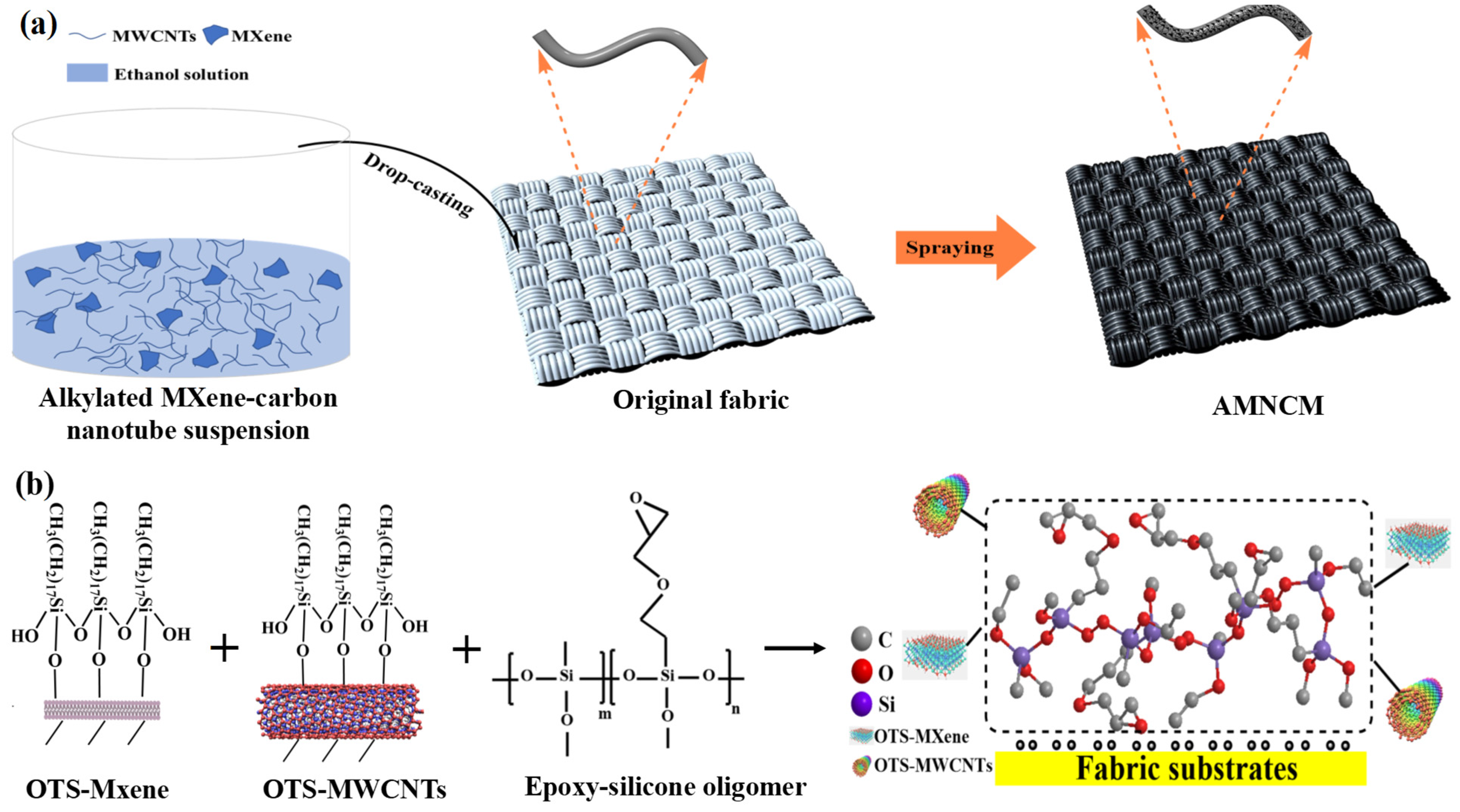
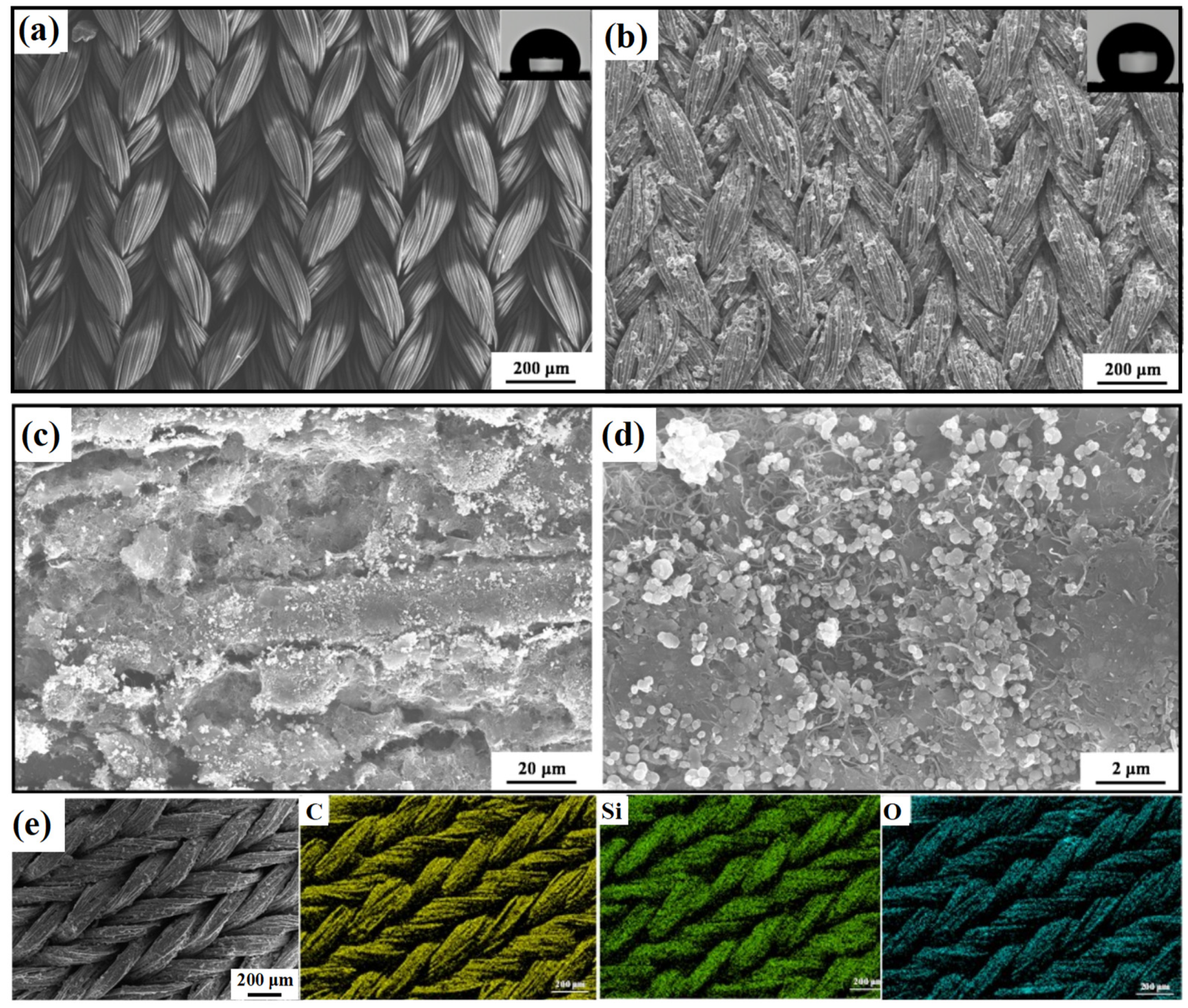
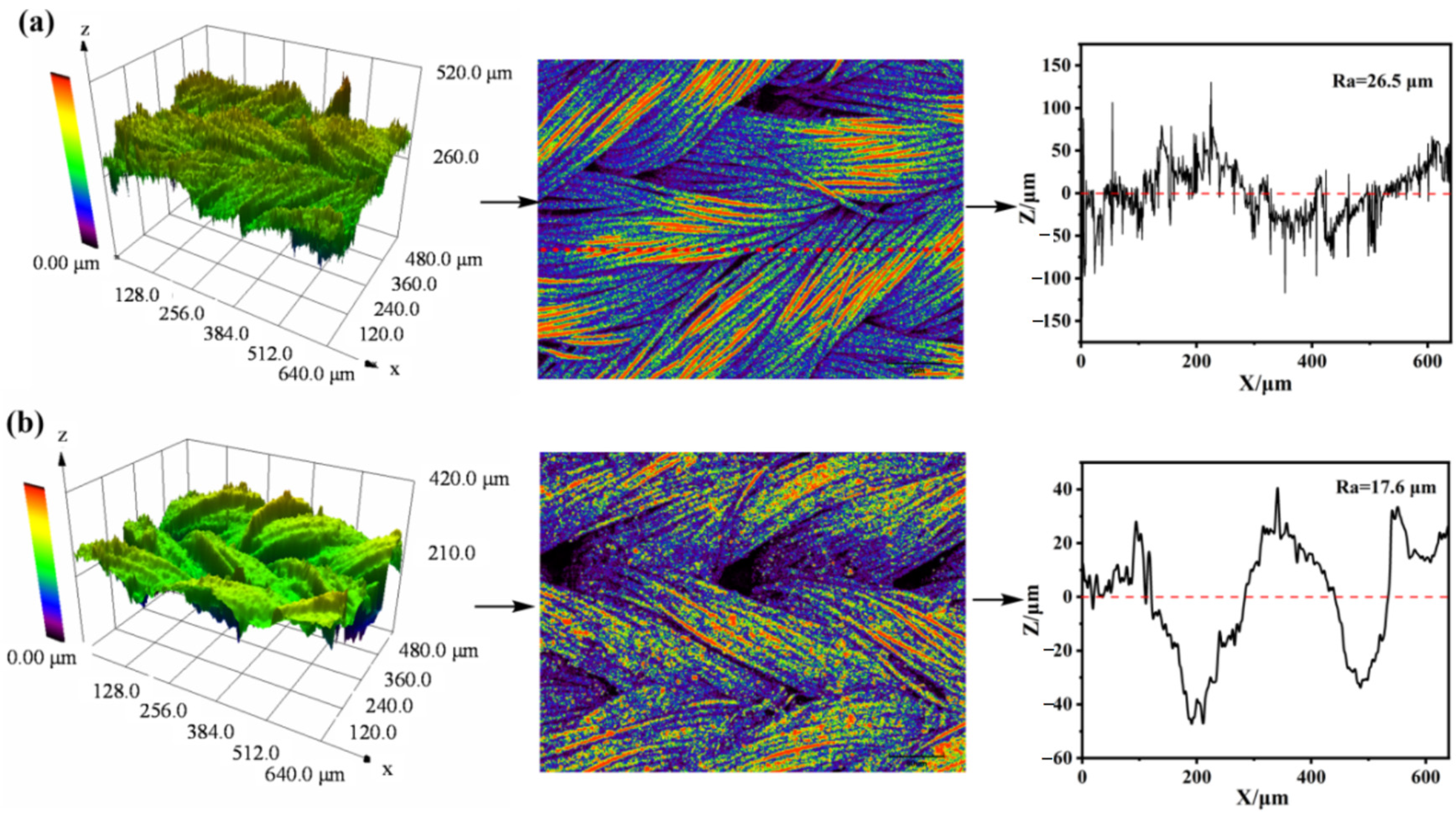
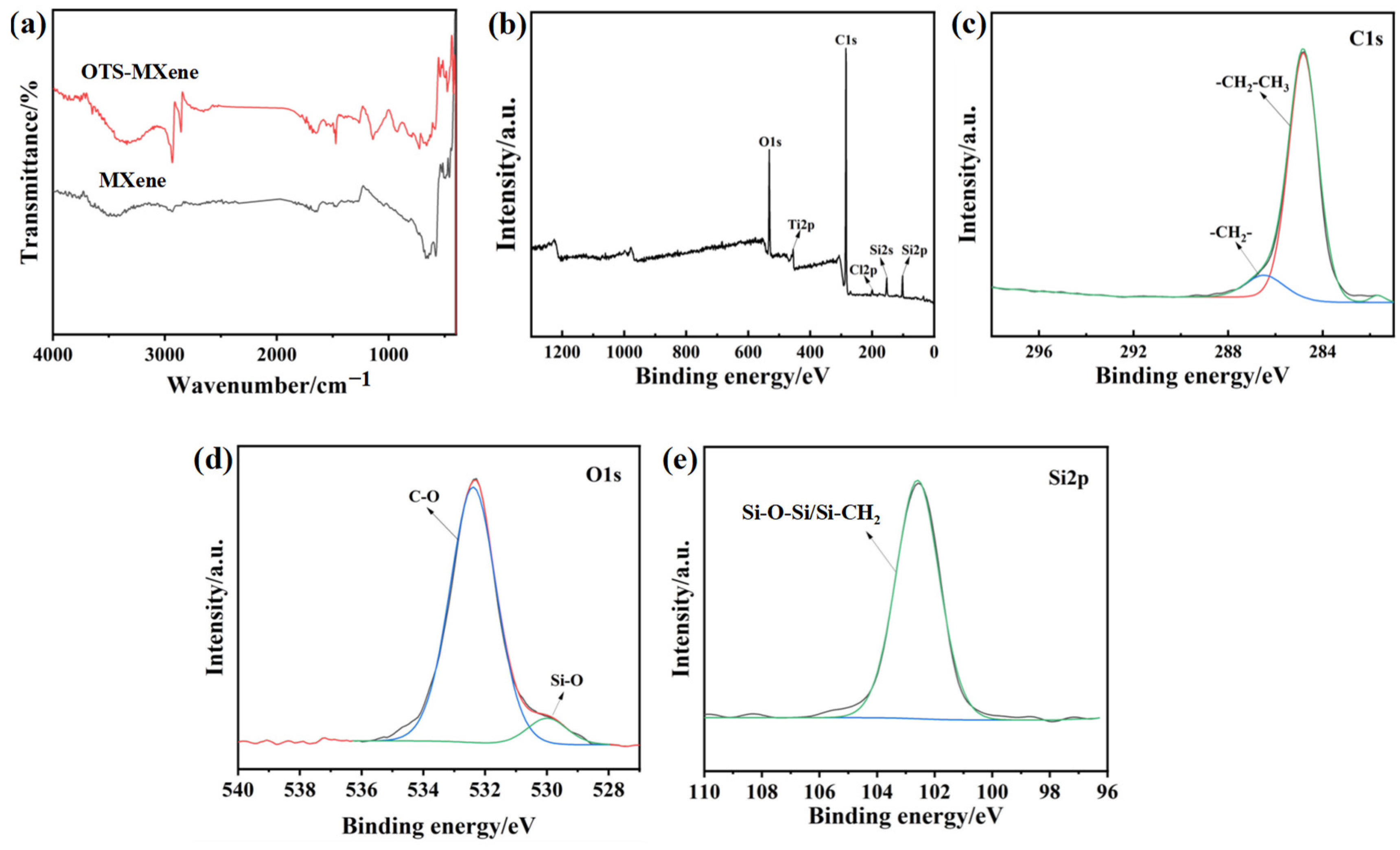
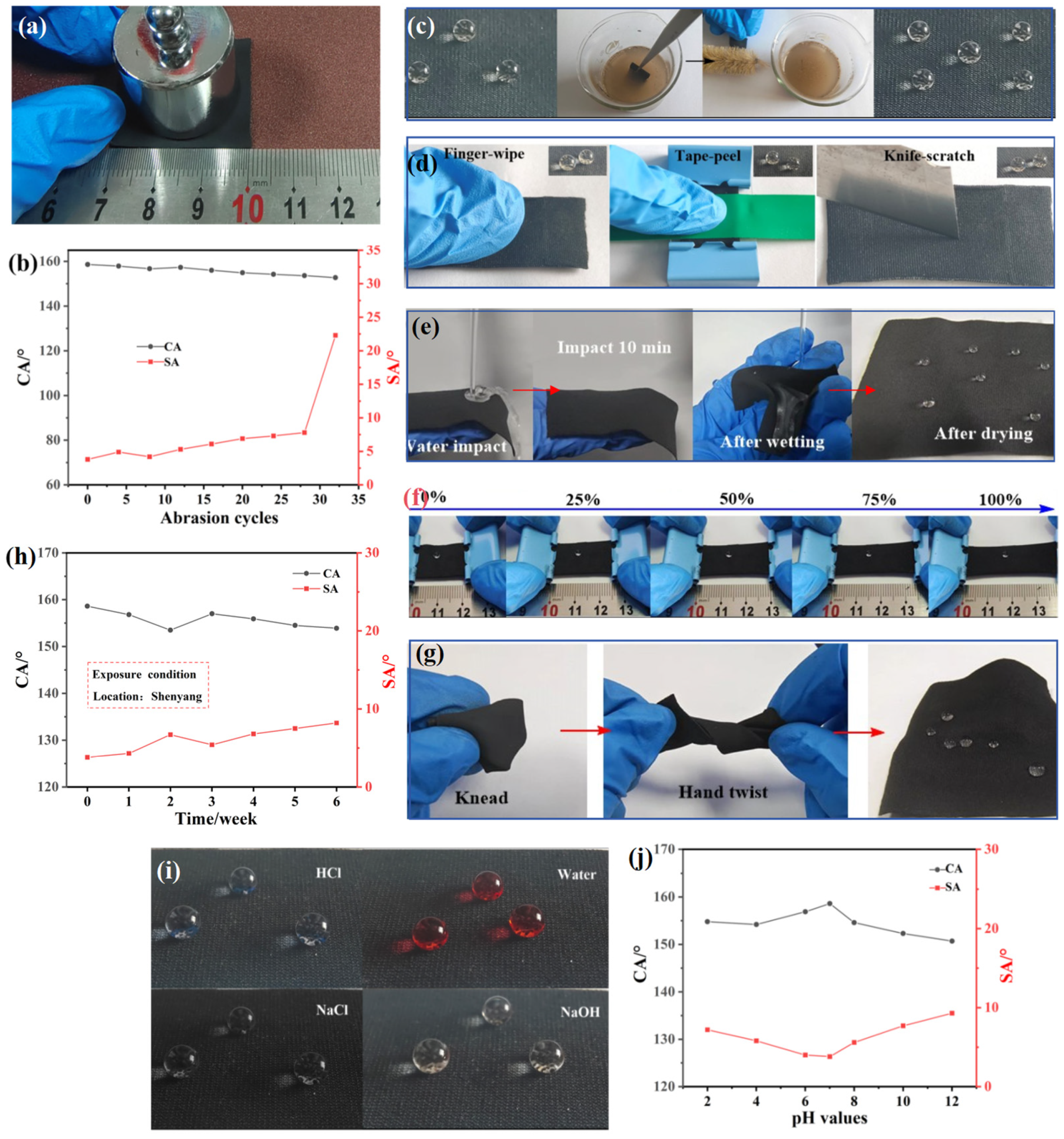
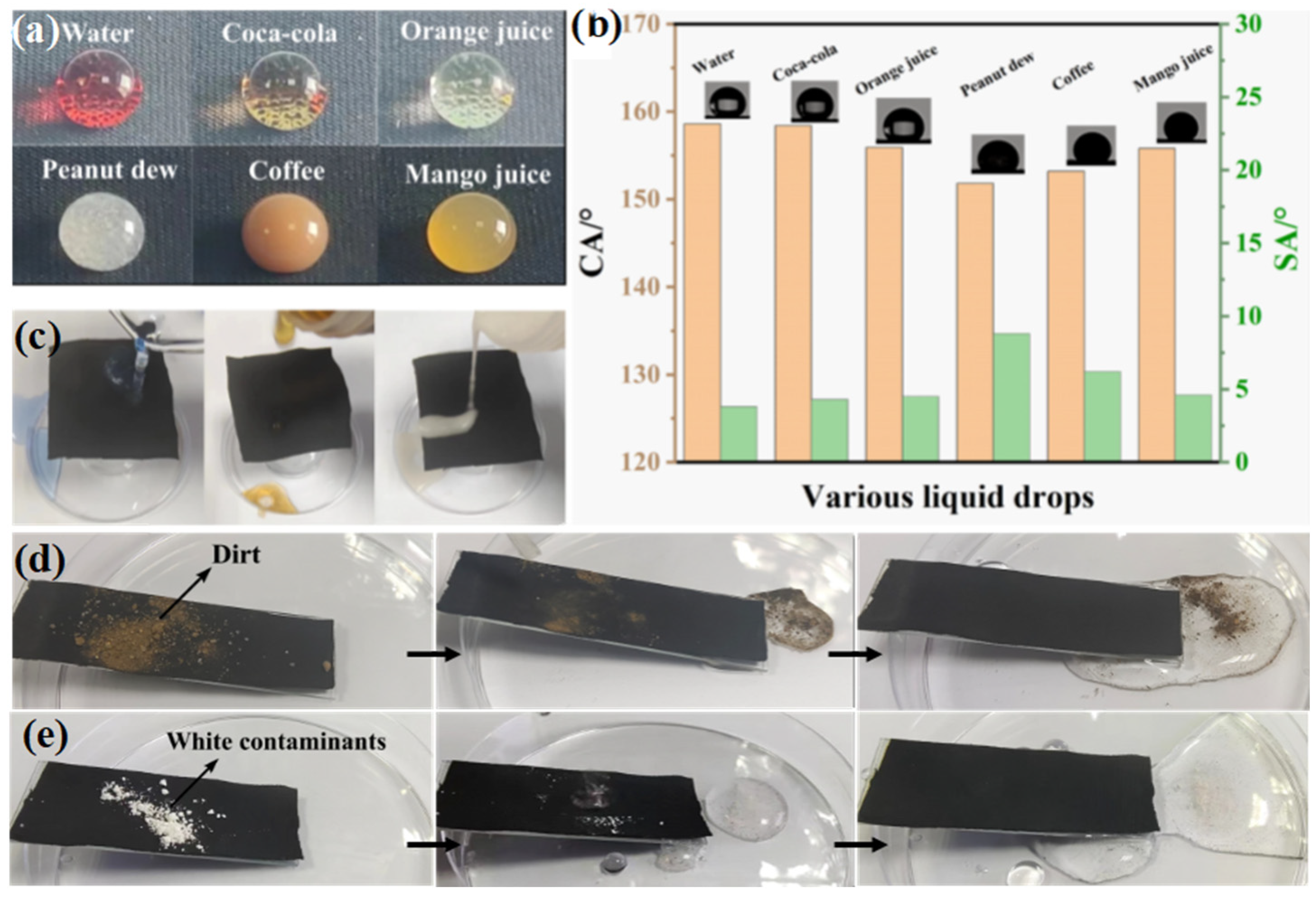
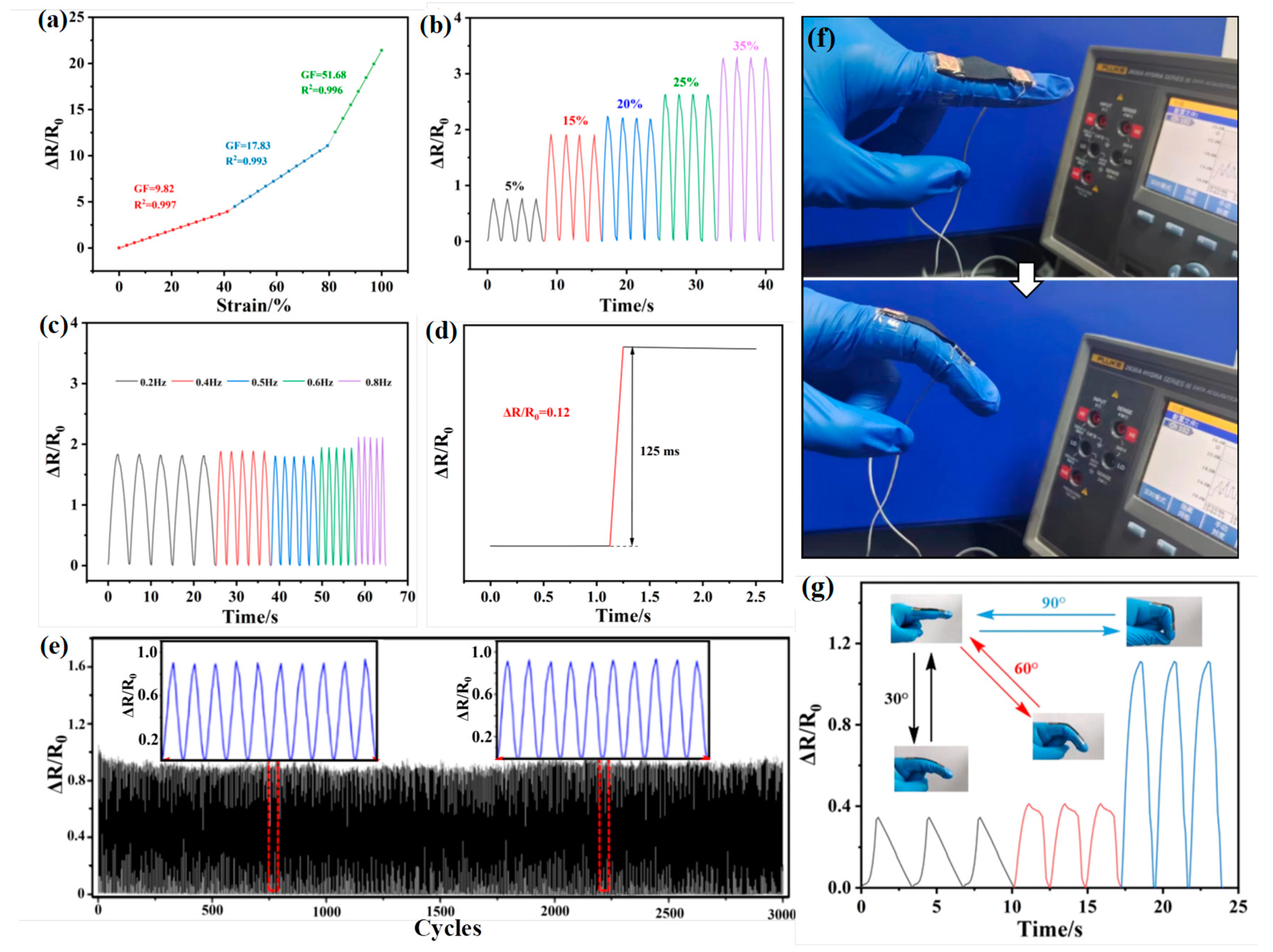
Disclaimer/Publisher’s Note: The statements, opinions and data contained in all publications are solely those of the individual author(s) and contributor(s) and not of MDPI and/or the editor(s). MDPI and/or the editor(s) disclaim responsibility for any injury to people or property resulting from any ideas, methods, instructions or products referred to in the content. |
© 2024 by the authors. Licensee MDPI, Basel, Switzerland. This article is an open access article distributed under the terms and conditions of the Creative Commons Attribution (CC BY) license (https://creativecommons.org/licenses/by/4.0/).
Share and Cite
Wang, S.; Xia, D.; Xu, X.; Song, H.; Qing, Y. Alkylated MXene–Carbon Nanotube/Microfiber Composite Material with Flexible, Superhydrophobic, and Sensing Properties. Materials 2024, 17, 4499. https://doi.org/10.3390/ma17184499
Wang S, Xia D, Xu X, Song H, Qing Y. Alkylated MXene–Carbon Nanotube/Microfiber Composite Material with Flexible, Superhydrophobic, and Sensing Properties. Materials. 2024; 17(18):4499. https://doi.org/10.3390/ma17184499
Chicago/Turabian StyleWang, Siyu, Dawei Xia, Xinyu Xu, Haoyang Song, and Yongquan Qing. 2024. "Alkylated MXene–Carbon Nanotube/Microfiber Composite Material with Flexible, Superhydrophobic, and Sensing Properties" Materials 17, no. 18: 4499. https://doi.org/10.3390/ma17184499
APA StyleWang, S., Xia, D., Xu, X., Song, H., & Qing, Y. (2024). Alkylated MXene–Carbon Nanotube/Microfiber Composite Material with Flexible, Superhydrophobic, and Sensing Properties. Materials, 17(18), 4499. https://doi.org/10.3390/ma17184499






